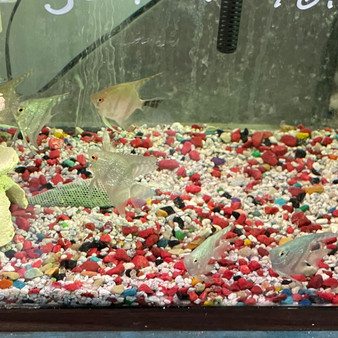Blue Philippine Angelfish
The Blue Philippine Angelfish is a captivating and vibrant addition to any freshwater aquarium. Known for its striking blue coloration and graceful swimming patterns, this angelfish species hails from the waters of the Philippines. Ideal for experienced aquarists, the Blue Philippine Angelfish adds a touch of elegance and exotic beauty to marine tanks.
Key Features
- Scientific Name: Pomacanthus annularis
- Common Name: Blue Philippine Angelfish, Blue Ring Angelfish
- Origin: Philippines
- Size: Up to 15 inches in the wild, typically smaller in captivity
- Lifespan: Up to 10 years with proper care
- Temperament: Semi-aggressive, territorial
- Diet: Omnivorous – requires a varied diet of algae, spirulina, marine-based frozen foods, and high-quality pellets
Tank Requirements
- Tank Size: Minimum 180 gallons
- Water Parameters:
- pH: 8.1 – 8.4
- Temperature: 72°F – 82°F (22°C – 28°C)
- Salinity: 1.020 – 1.025 SG
- Substrate: Live rock with plenty of hiding places
- Decor: Coral reefs, caves, and plenty of swimming space
Care Guide
The Blue Philippine Angelfish thrives in a well-established marine tank with stable water conditions. Regular water changes, a robust filtration system, and a protein skimmer are essential for maintaining water quality. They require a diet rich in marine algae and sponge-based foods to mimic their natural diet.
Breeding
Breeding Blue Philippine Angelfish in captivity is challenging due to their specific environmental needs and complex mating behaviors. They are protogynous hermaphrodites, meaning they can change sex from female to male. Successful breeding requires precise conditions and a large, mature tank.
Compatibility
- Best Kept With: Other large, semi-aggressive fish such as tangs, wrasses, and larger clownfish
- Avoid: Small, timid fish and other angelfish species that may provoke territorial disputes
Why Choose Blue Philippine Angelfish?
- Stunning Appearance: Their vibrant blue and yellow markings make them a centerpiece in any tank.
- Active Swimmers: Their graceful movements and curious nature provide endless entertainment.
- Unique Behavior: Their territorial and interactive behaviors add a dynamic aspect to the tank.








